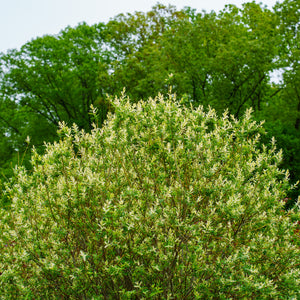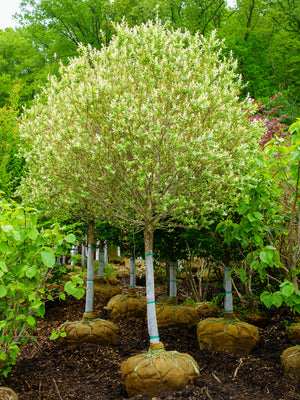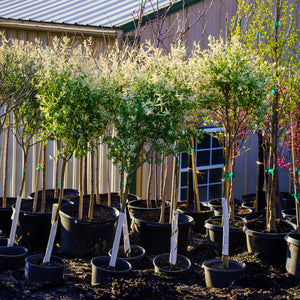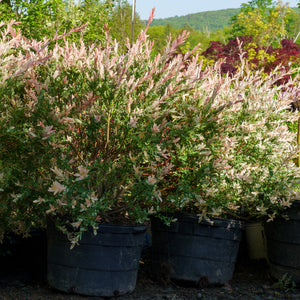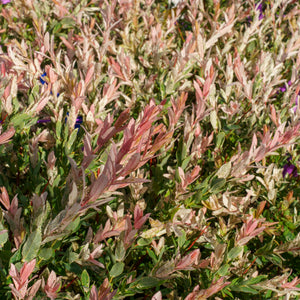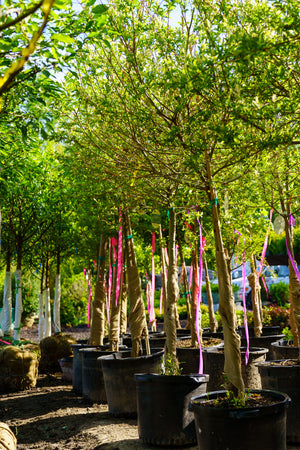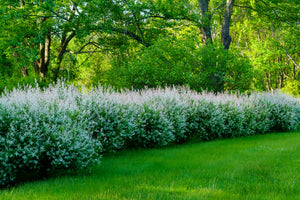Dappled Willow: Colorful Contrast with a Natural Touch
Welcome to this week’s edition of our "Plant of the Week" series. If you’re looking to bring energy and lightness into your garden, Dappled Willow (Salix integra 'Hakuro-Nishiki') offers one of the most striking displays in any landscape. With its pink, white, and green variegated foliage and graceful form, this fast-growing willow delivers both color and texture from spring through fall. Available in both multi-stemmed shrub and standard tree form, Dappled Willow is as versatile as it is beautiful—ideal for adding movement, contrast, and a dynamic focal point in gardens of all sizes.
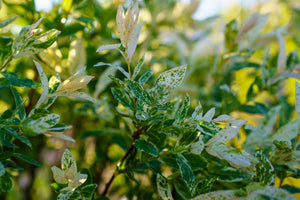

What Makes Dappled Willow Special?
Few plants put on a foliage show like Dappled Willow. In early spring, new leaves emerge a soft pink that gradually fades into a marbled combination of white, light green, and cream. This variegation continues through summer, offering brightness in both sun and part shade. The stems provide year-round interest too—particularly in winter, when their reddish tones stand out against dormant landscapes.
Growth is vigorous, and with regular pruning, the plant develops a rounded, billowing shape that sways with the wind—perfect for softening structures or bringing motion into the garden. In shrub form, Dappled Willow typically matures around 4 to 6 feet tall and wide, though it can be pruned to stay smaller or allowed to grow larger as a loose hedge.
The tree form, trained on a single trunk, usually tops out at around 6 to 8 feet, with a rounded canopy that creates an airy, ornamental silhouette. This version is particularly effective as a standalone specimen or accent near patios and walkways.
Dappled Willow is cold-hardy in zones 4 to 9, tolerates moist soil, and responds well to hard pruning, making it an easy-care option that rewards with season-long color and adaptable performance.
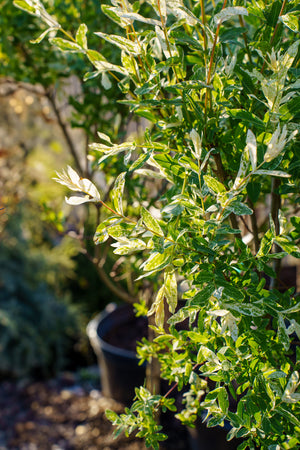
How to Use Dappled Willow in the Garden
Whether in shrub or tree form, Dappled Willow can be used in a wide variety of landscape roles thanks to its vibrant foliage and flexible size.
Foundation and Border Plantings: In shrub form, Dappled Willow brings lightness and contrast to darker evergreens and traditional border plants. Use it at the front or middle of a planting bed where its pink-and-white new growth can shine. It pairs beautifully with dark-leafed companions like Physocarpus or Weigela, and with perennials such as Salvia and Nepeta that emphasize the bright tones.
Mass Plantings or Hedges: Though not evergreen, a group of Dappled Willow shrubs can create an effective living screen or informal hedge. Spaced 4 to 6 feet apart, they quickly grow together into a lush mass of variegated foliage that softens fences or anchors mixed shrub borders.
Accent Trees for Patios or Entryways: The tree form is ideal for adding height and focal interest without heaviness. Plant one near a front walk, courtyard, or patio edge to draw the eye and offer seasonal color. The fine texture of the leaves and the soft movement of the canopy bring grace to structured spaces.
Rain Gardens and Moist Sites: Dappled Willow thrives in moist to wet soil, making it perfect for low-lying areas, rain gardens, or the edge of a pond. It can help manage runoff while offering beauty and seasonal change.
Focal Point in Mixed Beds: The coloring of Dappled Willow makes it a standout focal point, especially when surrounded by green or burgundy foliage. Its airy shape also offers a break from denser forms like boxwood or holly, helping balance the composition of a planting.

How to Care for Dappled Willow
Despite its delicate appearance, Dappled Willow is tough and fast-growing, and benefits from regular maintenance to stay vibrant.
Planting: Choose a site with full sun to partial shade. Full sun brings out the strongest color. Dappled Willow prefers loamy, consistently moist soil, but it will tolerate clay and heavier soils if drainage is adequate.
Watering: Keep the soil consistently moist, especially during hot weather. Though established plants tolerate short dry spells, growth and color may decline without regular watering.
Pruning: Prune annually in late winter or early spring to encourage fresh new growth, which provides the brightest color. You can also shape the shrub more frequently in summer to control size and enhance density. In tree form, remove suckers from the base to maintain the standard trunk.
Fertilizing: Apply a balanced fertilizer in early spring to support vigorous new growth. Organic compost can also be used to enrich the soil and maintain moisture.
Spacing: For shrub form, space 4 to 6 feet apart in mass plantings. Tree forms should be planted with room for the rounded canopy—at least 6 to 8 feet from nearby structures or shrubs.
Pests & Disease: Occasionally affected by leaf spots, aphids, or scale, especially in overly humid or crowded conditions. Regular pruning and airflow help prevent most issues. Willow trees also benefit from avoiding overhead watering.
CONCLUSION
Dappled Willow (Salix integra 'Hakuro-Nishiki') brings unmatched color, texture, and motion to the garden from early spring through fall. Whether you choose the versatile shrub or the elegant tree form, it offers a showy focal point and soft contrast to darker plantings. Easy to care for and quick to establish, it thrives in moist soils and responds well to shaping—making it a landscape favorite for gardeners who want maximum impact with minimal effort.

